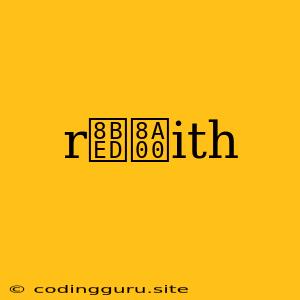Exploring the Power of R: A Beginner's Guide
R, a powerful programming language and free software environment, has become a cornerstone in the realm of statistical computing and data visualization. Its robust capabilities have made it an indispensable tool for researchers, data scientists, and analysts worldwide. But for newcomers, the vast world of R can seem daunting. So, how can you embark on your R journey and unlock its potential? Let's break it down.
What is R, and Why Should You Care?
R is a language and environment specifically designed for statistical computing and graphics. It's open-source, meaning it's free to use and modify, and boasts a vibrant community of developers who constantly contribute to its growth. Here's why R stands out:
- Statistical Powerhouse: R excels at statistical analysis, offering a vast library of packages for everything from basic descriptive statistics to advanced modeling techniques like regression, classification, and time series analysis.
- Data Visualization: R allows you to create high-quality, customizable visualizations using libraries like ggplot2, making it easy to communicate insights and trends from your data.
- Flexibility and Adaptability: R is incredibly flexible, allowing you to manipulate and analyze various data formats, including text files, spreadsheets, and databases.
- Active Community: The R community is massive, providing ample resources, tutorials, and forums to support your learning journey.
Getting Started with R: Your First Steps
-
Installation: Download and install R from the official CRAN (Comprehensive R Archive Network) website. The installation process is straightforward and will provide you with the core R environment.
-
RStudio: Your Coding Companion: While you can work directly with R, RStudio is a user-friendly Integrated Development Environment (IDE) that enhances your R experience. Download and install RStudio from their website. It offers features like syntax highlighting, code completion, and integrated plotting, making your coding process smoother.
-
Basic Commands: Let's start with some fundamental R commands:
print("Hello World!"): This is the classic "hello world" program, printing the text "Hello World!" to the console.?function_name: Use this command to access the documentation for a specific function. For example,?printwill display information about theprint()function.c(1, 2, 3): This command creates a vector (a sequence of values).
-
Packages: R's true power lies in its extensive collection of packages. Packages are like add-ons that provide specific functionalities. To use a package, you need to install it first. For example, to install the
ggplot2package:install.packages("ggplot2")- To load the package for use in your current session:
library(ggplot2)
Understanding R's Data Structures:
R uses various data structures to store and manipulate information. Here are some key ones:
- Vectors: One-dimensional arrays that store a sequence of values.
- Matrices: Two-dimensional arrays that store data in rows and columns.
- Data Frames: Tabular data structures that can hold different data types within columns, similar to spreadsheets.
- Lists: Flexible data structures that can hold different data types and structures, including vectors, matrices, and other lists.
Exploring R's Statistical Functions:
R comes equipped with a wide range of statistical functions for analysis and modeling:
- Descriptive Statistics:
mean(x): Calculate the average of a vector.median(x): Find the middle value in a sorted vector.sd(x): Calculate the standard deviation.var(x): Calculate the variance.
- Linear Regression:
lm(y ~ x): Fits a linear regression model whereyis the dependent variable andxis the independent variable.
Visualizing Data with ggplot2:
ggplot2 is a powerful library that allows you to create compelling and informative visualizations. It's based on the grammar of graphics, which provides a consistent framework for creating plots.
- Basic Scatter Plot:
ggplot(data, aes(x = x_variable, y = y_variable)) + geom_point()
- Bar Chart:
ggplot(data, aes(x = x_variable, y = y_variable)) + geom_bar(stat = "identity")
Beyond the Basics: Expanding Your R Skills
As you gain confidence with the fundamentals, you can delve into more advanced R concepts:
- Data Wrangling with
dplyr:dplyris a powerful package for data manipulation, making it easier to filter, select, arrange, and summarize your datasets. - Data Manipulation with
tidyr:tidyrprovides tools to reshape and restructure your data into tidy formats for analysis and visualization. - Time Series Analysis with
forecast: This package allows you to model and forecast time series data, identifying trends and seasonal patterns.
R in Action: Real-World Applications
- Data Analysis in Research: Scientists and researchers use R to analyze data, test hypotheses, and draw conclusions from experiments and surveys.
- Business Intelligence: Companies use R for data exploration, customer segmentation, and predicting market trends.
- Financial Modeling: R is widely used in finance for portfolio analysis, risk management, and asset pricing.
Tips for Success in R:
- Start with the Basics: Don't get overwhelmed by the breadth of R. Focus on mastering the core concepts and gradually expand your knowledge.
- Practice Regularly: The best way to learn R is by practicing. Work through examples, try different commands, and explore data sets.
- Explore Online Resources: There are countless resources available online, including tutorials, blog posts, and forums.
- Join the Community: Connect with other R users in online forums or local meetups. Sharing knowledge and experiences can accelerate your learning process.
Conclusion
R, with its powerful capabilities and vast ecosystem, offers a rewarding journey into the world of data analysis and visualization. It empowers you to explore data, uncover insights, and communicate findings effectively. By embracing its flexibility and learning its nuances, you can harness R's power to drive innovation and knowledge in your chosen field.
